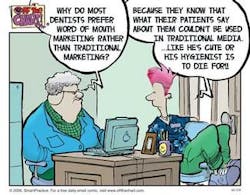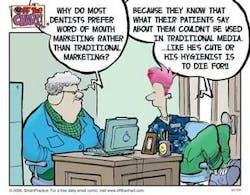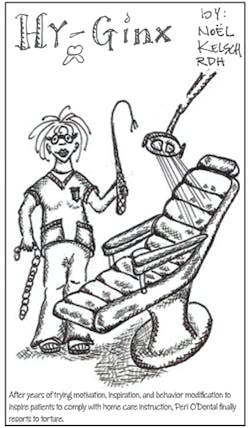Readers’ forum
Journey in public health
Dear RDH:
What a wonderfully written profile (November 2005 issue) on a motivating dental hygienist! Mary Foley is a true pioneer in dental public health. I hope she can become my mentor. I will be volunteering for a project to help moms and their kids in a perinatal recovery network. These women are recovering from drug dependency and learning life skills to care for their families.
I, too, have been in dental hygiene for 30 years, and share Mary Foley’s journey in private practice/education/public health. In June 2005, I completed my studies at the University of the Pacific (UOP) in San Francisco to become licensed in alternative practice. A detailed description on the Pacific Center for Special Care was written by Christine E. Miller, RDH, MHS, MA, in “CDA Journal of the California Dental Association” (September 2005, page 715).
We all have so much to give in dental public health.
Elizabeth Xiu-juan Wong, RDHAP
Sacramento, California
Nevada public health
Dear RDH:
Sometime near the end of my senior year at the Community College of Southern Nevada, I engaged in a discussion of my community service project with my professor, Theresa Raglin. My partner, Amanda, and I had just completed a satisfying eight weeks teaching various aspects of oral health to teenage wards of the state, and I bubbled over with enthusiasm as I described our project to my teacher. At the end of our conversation I remember professor Raglin saying, “Why, Annette, you may just become our first public health hygienist!” I was appalled. Certainly not. I was sure I wanted a challenging position in a periodontal office, the bloodier the better.
Three years later, I began my current job as the dental hygienist at the Huntridge Teen Clinic, a private donation and grant funded public health facility dedicated to increasing access to care for teenagers without dental insurance. I am one of only 20 public health dental hygienists in the state of Nevada. I was not the first, and I know I won’t be the last, but I may be the happiest.
Nevada law allows the endorsed Public Health Dental Hygienist (PHDH) to practice “without supervision by a dentist and without authorization from the licensed dentist of the patient on whom the services are to be performed.” The PHDH is limited to practicing at an approved facility or within an approved program as specified in an official Public Health Dental Hygiene Endorsement letter issued by the Nevada State Board of Dental Examiners. The individual endorsements must be renewed annually. The duties allowed the PHDH are essentially the same as duties delegable to dental hygienists under authorized practice in Nevada, with the addition of diagnosing and placing pit and fissure sealants without the supervision of a dentist.
The non-profit dental program at the Huntridge Teen Clinic is unique. There are no dentists on staff. In fact, there are currently only two dental employees - myself and a dental assistant/dental facilitator. We rely on dentists from our community to volunteer time at our clinic to provide the restorative care our at-risk teenage patients receive. I provide the hygiene care with absolute autonomy. As the PHDH at the clinic I am responsible for triage with respect to restorative care, as well as a growing list of administrative duties. In fact, my clinical duties and administrative duties are almost evenly split. Some of the administrative duties include writing letters to volunteer dentists regarding patient treatment, hiring and supervising the dental assistant, tabulating and reporting statistical information, writing a monthly newsletter, ordering supplies, and representing the clinic at various meetings, both local and statewide. Of course, there are countless other tasks that arise from time to time. My day is never boring.
The dental clinic is growing too. We are currently expanding the facility from two treatment rooms to four, and adding a darkroom and panoramic radiograph capability. With the expansion we will be able to host student dentists from the University of Nevada Las Vegas School of Dental Medicine as they fulfill their community service class requirements. Also, with the expansion will come the necessity for a larger dental staff and increased supervisory responsibilities.
I hope the Huntridge Teen Clinic will become a model for other nonprofit, public health dental programs everywhere. It is the perfect atmosphere for the future of dental hygiene, the Advanced Dental Hygiene Practitioner. I see no limit to our future growth and effectiveness in our community.
Annette Lincicome, BS, RDH
Las Vegas, Nevada
Girlie magazine?
Dear RDH:
For many years I have read your magazine from cover to cover. Yet the moment I received the December 2005 issue, I was taken back by the cover. This looks like a “girlie magazine” instead of a professional journal. When I walked out of the mailroom at my hospital, a staff member acknowledged the lady sure had a nice bosom!
What does this picture say about dental hygiene? The young lady on the cover is lovely and the picture inside on page six is equally flattering and would have made a wonderful picture for our cover, but certainly not the one on the present cover with hands on her hips, bust out, and low rider pants.
Norma Probus, RDH
Cartersville, Georgia
Opportunities with expanded functions
Dear RDH:
The article on the “restorative dental hygienist” (page 32, November 2005 issue) was very interesting. Great things are being accomplished on the West Coast. Your comment that only “Washington State allows dental hygienists to not only place ...” should have included Missouri. Missouri has the most liberal rules for placing and finishing restorations that I have seen. The rules were written for dental assistants who pass a weekend Basic Skills Exam and then pass a weekend training course in either restorative, orthodontics, or prosthetics, and provide the expanded services, including pack, carve, and finish amalgam and composite restorations. Dental hygienists licensed in Missouri don’t have to take the Basic Skills Exam, but they do have to take the other training courses.
These services are so necessary to providing better access to care to those who so desperately need it. The dental hygienist with the extensive training and knowledge is the precise person to provide these expanded functions.
I was an AmeriCorps/VISTA volunteer the past two years in a mid-Missouri rural community. It was the best experience of my 30 years as a dental hygienist. I was assigned to a preventive oral health program called Bright Smiles - the only one of its kind in the state. The children (kindergarten through third grade) brush every morning at school before classes begin. They also have preventive dental programs in the classrooms periodically.
Water fluoridation was accomplished for which we received an award from the ASTDD at the National Oral Health conference. The decay rate dropped from more than 37 percent to 6 percent in three years.
The program also works with Miles for Smiles, a mobile dental unit that goes to the schools. This year, they have hired a hygienist and I hope they will be able to utilize the expanded functions. I would have taken the position if I had not moved back to northern Illinois. What an exciting opportunity!
Fran Tourdot, RDH, BS
Worth, Illinois
Relying on outdated information
Dear RDH:
Upon receiving my November issue of RDH, I was very excited to see an article on restorative dental hygienists, as I am a restorative functions dental hygienist in Minnesota. I must admit, however, I was equally disappointed in the article and its accuracy. With the advancing of the profession of dental hygiene moving so rapidly, I was extremely disappointed that the statistics used for the article are more than a year old (September 2004). The article states that “only Washington state allows dental hygienists to not only place amalgam material, but also pack, carve, and finish amalgam and composite restorations” when, in fact, Minnesota also allows those functions for the registered dental assistant and registered dental hygienist who have successfully completed advanced education to develop competencies that have been set forth by the Minnesota Board of Dentistry.
In Minnesota, the RDA and RDH who have completed the above education can, under the supervision of a dentist, place, carve, and adjust amalgam restorations (Class I, II, V), glass ionomers (Class I, II, V), supragingival composite restorations where margins are entirely within the enamel (Class I, V), as well as adjusting the occlusion of newly placed restorations and adapting and cementing stainless steel crowns.
While working in a rural general practice in northeastern Minnesota, my new education has not only expanded my dental hygiene duties but has allowed the practice in which I am employed to see additional new patients and emergencies who would not otherwise be able to receive dental treatment due to the lack of dentists in the area and/or those who are not or cannot accept new patients.
I am excited about the advancement of our profession and feel that each and every state works exceptionally hard to acquire the functions they need to meet the needs of the dental patient population; therefore, I feel that each state deserves credit for their accomplishments. Being a restorative functions hygienist, I had to speak out the for hard work and effort the Minnesota dentists, hygienists, assistants, and the Board of Dentistry have put forth to accomplish this task.
I look at RDH as a dental magazine that keeps up with the times; so you can see why I was disappointed with the outdated statistics.
Sondra Nickolson, CDA, RDA, RDH, RF, MEd
Ely, Minnesota
No therapeutic benefit?
Dear RDH:
In reference to the December 2005 column, From the Edge, is there a misprint? Lory Laughter cannot be for real. How could she possibly have gotten a license to practice dental hygiene believing there is no therapeutic benefit from removal of supragingival plaque? This is preposterous, idiotic and totally false. If she really believes that, why bother to even go to the trouble of brushing?
Gloria Juilfs, RDH
Des Moines, Iowa
Editor’s Note: The author observes that the definition of therapeutic centers on the treatment of disease with “remedial agents or methods,” according to any standard dictionary. Ms. Laughter adds, “Periodontal disease is a bacterial infection, and we are not treating that disease by removing plaque and stain from above the gumline. As dental hygienists, we treat the disease by removing (as much as possible) and disrupting bacterial bioflims from the subgingival surfaces and by removing the calculus where these colonies thrive.” She also points out that while brushing off supragingival plaque may have some preventive value, “it is not therapeutic. The bacterial disease (either periodontal or caries) is not being treated or cured by brushing. Also, brushing can be accomplished by the majority of patients at home without out professional assistance ... we should and can offer patients more while they are in our care.”
An alternative to the sacred cow
Dear RDH:
In response to your article in the December 2005 issue of RDH titled, “Is Flossing Dental Hygiene’s Sacred Cow?” by Carol A. Jahn, RDH, MS. Well, no. The reality is flossing has been a sacred cow since its introduction in 1815 - for all of dentistry, not just dental hygiene.
Not long after I started practicing dental hygiene in 1984 I had the privilege of seeing a patient I’ll call Bill, not to protect his identity, but because I can’t remember his name. One of the admissions Bill made right up front was the frequency of flossing. He said he would really like to floss more, but once every month or two was all he could manage. He tried, but it was just too difficult, despite the fact that every six months he was told by the dentist and dental hygienist he needed to floss every day. Bill is a very able-bodied person of about 40 years with fingers made for bricklaying and a full knuckle shorter than mine. No wonder he had such a difficult time; he couldn’t reach his bicuspids, let alone his molars when trying to floss!
I was a bit angry at his previous dentists and dental hygienists for not realizing the cause of Bill’s problem. I simply told him to totally disregard the idea of flossing - regardless of what any other dentist or dental hygienist has told him in the past, or what they may recommend in the future. It has not worked for him in 30 years. Unless his fingers become slender and grow another knuckle in length, it will not work in the future, no matter how much dentists and dental hygienists tell him it will.
I told Bill he had carte blanche here, find anything in the dental care aisle of any grocery store, pharmacy, or health food store that he thought might work to clean between his teeth. Buy it, try it. If it works, keep using it; if it doesn’t work, toss it, and go back to the store. The definition for “working” only had two requirements. First, the “tool” had to do what it was supposed to. Secondly, he had to use it frequently. My initial suggestion was a rubber-tipped stimulator from Sunstar Butler. At the time I did not have one to give him, so he had to go out and buy one himself.
Six months later when I next saw Bill, he was very happy. He said he tried the rubber-tipped stimulator and really liked it; he could easily reach his molars! His perio charting was a complete turnaround. All readings had gone from 3’s, 4’s, 5’s and 6’s with circumferential bleeding freely everywhere to readings all within normal limits and no bleeding. Bill told me he liked the results he was getting with the first RTS and got another for the downstairs bathroom. He put one in his truck and that worked, so he put one in his car. He said he even put one next to his recliner so when he was “...watching the news after dinner” he could massage his gums.
He got it! Yes! And it reaffirmed for me that the bull (sacred cow) I was exposed to in dental hygiene school “... if you have a patient with bleeing gums, they need to floss more...” was bull. Flossing is not, nor has it ever been, a cure-all panacea. So what do you do when “more flossing” doesn’t improve the condition? You ever heard of a phase-contrast microscope? I have, but that’s another story ... with a major paradigm shift.
Gary Schimelfenig, RDH
Wenatchee, Washington
How would you like to see yourself, or a small group of your friends, on the cover of RDH Magazine? The August 2006 cover of RDH magazine is the grand prize in a raffle organized by dental hygiene members of the online RDH Lister’s Relief Fund.
Dental hygienists suffered serious property damage in Mississippi, Louisiana, Texas, and Florida as a direct result of hurricanes Katrina, Rita, and Wilma. The need for an ongoing relief fund became clear. The RDH Lister’s Relief Fund, a non-profit organization, was created to collect and distribute funds to dental hygienists facing an unexpected loss from a natural disaster or life-threatening event. Since September 1, 2005, more than $17,000 has been raised.
This is an ideal opportunity to make a charitable donation to help fellow dental hygienists and turn your dream of being a cover model into reality! Tickets are available at www.anneguignon.com.
To submit letters to the editor, send to: RDH, P.O. Box 3408, Tulsa, OK 74101; [email protected]; or (918) 831-9804 (fax).


